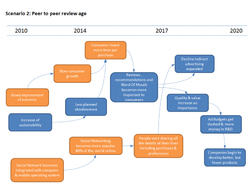Difference between revisions of "Scenario 2: Peer to peer review age"
Dcateriano (talk | contribs) |
Dcateriano (talk | contribs) |
||
| Line 20: | Line 20: | ||
==Reference== | ==Reference== | ||
Revision as of 13:59, 15 October 2009
Description
2010 - 2013: Economic Uncertainty & Growing sustainability
In the aftermath of the current economic slowdown, consumers continue to be reticent about purchases. The threat of falling back into a recession, or even a depression, shown by lingering high unemployment (In addition to replacing 7.2 million lost jobs, the economy needs an additional 100,000 a month to keep up with population growth. If the job market returns to the rapid pace of the 1990s -- adding 2.15 million private-sector jobs a year, double the 2001-2007 pace -- the U.S. wouldn't get back to a 5% unemployment rate until late 2017 ), weighs down unneeded purchases and boosts the savings rate and credit payback rates. This also coincides with some traction by the sustainability movement towards encouraging fewer designed obsolescence purchases.
2014 - 2016: Reticence & Reviews
As people begin to make fewer purchases they start to take the time to analyze more that which they are buying. People begin to ask family and friends more about purchases. Brick and Mortar stores start placing cheap PC’s around their store so that consumers can look online to compare prices and get reviews. Cell phone technology which allows photos of items to instantly bring back reviews becomes more mainstream. The government continues to draft legislation which punishes firms for buying reviews, deleting unfavorable reviews, and faking information. Social networking expands to the baby boomers and becomes more integrated with computer OS. As the quality of the product gains importance, tight money must be reallocated at firms as they try to improve their products and since peer to peer recommendations are more important.
2017 - 2020
Ad budgets get slashed with the money going to better inputs and R&D. Once this process begins, products begin to disappear from shelves as companies begin to develop better, but fewer products. Advertising becomes more generic and is about brand awareness rather than trying to convince customers to make purchases.
2020
In the the current economic slowdown, consumers continue to be reticent about purchases. The threat of falling back into a recession, or even a depression, shown by lingering high unemployment, weighs down unneeded purchases and boosts the savings rate and credit payback rates. This also coincides with some traction by the sustainability movement towards encouraging fewer designed obsolescence purchases.People begin to ask family and friends more about purchases. Brick and Mortar stores start placing cheap PC’s around their store so that consumers can look online to compare prices and get reviews. Cell phone technology which allows photos of items to instantly bring back reviews becomes more mainstream. The government continues to draft legislation which punishes firms for buying reviews, deleting unfavorable reviews, and faking information. Social networking expands to the baby boomers and becomes more integrated with computer OS. As the quality of the product gains importance, tight money must be reallocated at firms as they try to improve their products and since peer to peer recommendations are more important, ad budgets get slashed with the money going to better inputs and R&D. Once this process begins, products begin to disappear from shelves as companies begin to develop better, but fewer products. Advertising becomes more generic and is about brand awareness rather than trying to convince customers to make purchases.
Reference
- http://apnews.myway.com/article/20091004/D9B4D6C01.html
- http://online.wsj.com/article/SB125470053662262957.html?mod=WSJ_hps_sections_careerjournal
- http://www.msnbc.msn.com/id/33177160/ns/technology_and_science-tech_and_gadgets/
- http://www.ft.com/cms/s/4c854634-b1db-11de-a271-00144feab49a,Authorised=false.html?_i_location=http%3A%2F%2Fwww.ft.com%2Fcms%2Fs%2F0%2F4c854634-b1db-11de-a271-00144feab49a.html&_i_referer=
- http://www.pcworld.com/article/172188/windows_mobile_7_the_social_networking_phone_os.html
